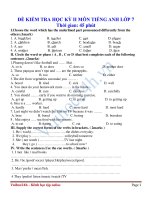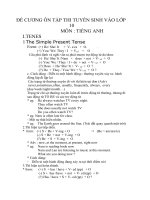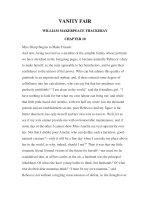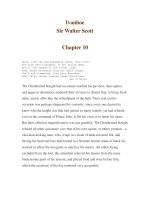Number operation review 10 pot
Bạn đang xem bản rút gọn của tài liệu. Xem và tải ngay bản đầy đủ của tài liệu tại đây (141.2 KB, 6 trang )
c ϩ 2d ϭ 13
c ϩ 2(11 Ϫ 2c) ϭ 13
c ϩ 22 Ϫ 4c ϭ 13
22 Ϫ 3c ϭ 13
22 ϭ 13 ϩ 3c
9 ϭ 3c
c ϭ 3
Now substitute this answer into either original equation for c to find d.
2c ϩ d ϭ 11
2(3) ϩ d ϭ 11
6 ϩ d ϭ 11
d ϭ 5
Thus, c ϭ 3 and d ϭ 5.
Linear Combination
Linear combination involves writing one equation over another and then adding or subtracting the like terms so
that one letter is eliminated.
Example
x Ϫ 7 ϭ 3y and x ϩ 5 ϭ 6y
First rewrite each equation in the same form.
x Ϫ 7 ϭ 3y becomes x Ϫ 3y ϭ 7
x ϩ 5 ϭ 6y becomes x Ϫ 6y ϭϪ5.
Now subtract the two equations so that the x terms are eliminated, leaving only one variable:
x Ϫ 3y ϭ 7
Ϫ (x Ϫ 6y ϭϪ5)
(x Ϫ x) ϩ (Ϫ 3y ϩ 6y) ϭ 7 Ϫ (Ϫ5)
3y ϭ 12
y ϭ 4 is the answer.
Now substitute 4 for y in one of the original equations and solve for x.
x Ϫ 7 ϭ 3y
x Ϫ 7 ϭ 3(4)
x Ϫ 7 ϭ 12
x Ϫ 7 ϩ 7 ϭ 12 ϩ 7
x ϭ 19
Therefore, the solution to the system of equations is y ϭ 4 and x ϭ 19.
–ALGEBRA REVIEW–
89
Systems of Equations with No Solution
It is possible for a system of equations to have no solution if there are no values for the variables that would make
all the equations true. For example, the following system of equations has no solution because there are no val-
ues of x and y that would make both equations true:
3x ϩ 6y ϭ 14
3x ϩ 6y ϭ 9
In other words, one expression cannot equal both 14 and 9.
Practice Question
5x ϩ 3y ϭ 4
15x ϩ dy ϭ 21
What value of d would give the system of equations NO solution?
a. Ϫ9
b. Ϫ3
c. 1
d. 3
e. 9
Answer
e. The first step in evaluating a system of equations is to write the equations so that the coefficients of one
of the variables are the same. If we multiply 5x ϩ 3y ϭ 4 by 3, we get 15x ϩ 9y ϭ 12. Now we can com-
pare the two equations because the coefficients of the x variables are the same:
15x ϩ 9y ϭ 12
15x ϩ dy ϭ 21
The only reason there would be no solution to this system of equations is if the system contains the
same expressions equaling different numbers. Therefore, we must choose the value of d that would
make 15x ϩ dy identical to 15x ϩ 9
y.Ifd ϭ 9, then:
15x ϩ 9y ϭ 12
15x ϩ 9y ϭ 21
Thus, if d ϭ 9, there is no solution. Answer choice e is correct.
Functions, Domain, and Range
A function is a relationship in which one value depends upon another value. Functions are written in the form
beginning with the following symbols:
f(x) ϭ
For example, consider the function f(x) ϭ 8x Ϫ 2. If you are asked to find f(3), you simply substitute the 3
into the given function equation.
–ALGEBRA REVIEW–
90
f(x) ϭ 8x Ϫ 2
becomes
f(3) ϭ 8(3) Ϫ 2f(3) ϭ 24 Ϫ 2 ϭ 22
So, when x ϭ 3, the value of the function is 22.
Potential functions must pass the vertical line test in order to be considered a function. The vertical line test
is the following: Does any vertical line drawn through a graph of the potential function pass through only one point
of the graph? If YES, then any vertical line drawn passes through only one point, and the potential function is a
function. If NO, then a vertical line can be drawn that passes through more than one point, and the potential func-
tion is not a function.
The graph below shows a function because any vertical line drawn on the graph (such as the dotted verti-
cal line shown) passes through the graph of the function only once:
The graph below does NOT show a function because the dotted vertical line passes five times through the
graph:
x
y
x
y
–ALGEBRA REVIEW–
91
All of the x values of a function, collectively, are called its domain. Sometimes there are x values that are out-
side of the domain, but these are the x values for which the function is not defined.
All of the values taken on by f(x) are collectively called the range. Any values that f(x) cannot be equal to are
said to be outside of the range.
The x values are known as the independent variables. The y values depend on the x values, so the y values
are called the dependent variables.
Practice Question
If the function f is defined by f(x) ϭ 9x ϩ 3, which of the following is equal to f(4b)?
a. 36b ϩ 12b
b. 36b ϩ 12
c. 36b ϩ 3
d.
ᎏ
4b
9
ϩ 3
ᎏ
e.
ᎏ
9
4
ϩ
b
3
ᎏ
Answer
c. If f(x) ϭ 9x ϩ 3, then, for f(4b), 4b simply replaces x in 9x ϩ 3. Therefore, f(4b) ϭ 9(4b) ϩ 3 ϭ 36b ϩ 3.
Qualitative Behavior of Graphs and Functions
For the SAT, you should be able to analyze the graph of a function and interpret, qualitatively, something about
the function itself.
Example
Consider the portion of the graph shown below. Let’s determine how many values there are for f(x) ϭ 2.
x
y
–ALGEBRA REVIEW–
92
When f(x) ϭ 2, the y value equals 2. So let’s draw a horizontal line through y ϭ 2 to see how many times the
line intersects with the function. These points of intersection tell us the x values for f(x) ϭ 2. As shown below, there
are 4 such points, so we know there are four values for f(x) ϭ 2.
x
y
Four points
of intersection
at y = 2
–ALGEBRA REVIEW–
93









